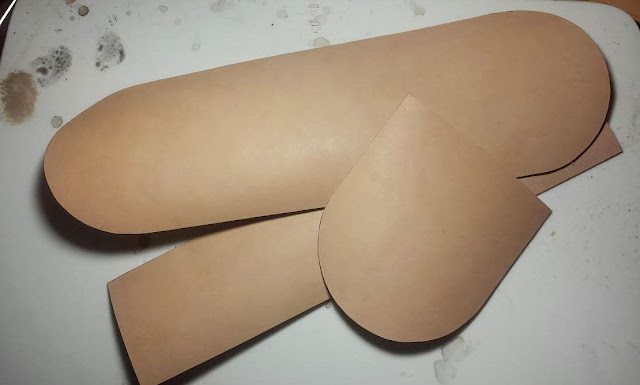You may remember that I mentioned the other day that Lee Slikkers of Slikkers Split Cane has a lot of talent in many areas and I am excited to share how he creates and builds his leather reel cases. I commissioned this one for myself and already have a second one in the works as these are certainly heirloom pieces that will be passed on to my children someday.
This series of posts will be broken into two parts and the step by step certainly helps to put into perspective the level of craftsmanship and time it takes to complete each leather reel case.
Lee wrote... "Currently the temps in southwest Michigan are bone chilling cold and the snow is
deep here for a
Bamboo Rod Maker who works out of an unheated garage. This means winter is my
down time and I have found through the
years that if I’m not making something with my hands that I tend to go a bit crazy. I look for things I can do or make that might add to my fly fishing
experiences in life.
Recently while staring off with a
glazed look in my eye I spotted my case-less Speyco reel and I decided to do
something about that issue.
I've worked leather a bit in the past but mainly for
utilitarian purposes such as knife or ax sheaths, equipment and hoods for my
Falconry birds, etc., so I was lucky to have some basic tools and even a few
square feet of leather in the closet to play around with. I've seen nice leather reel cases in my fishing travels out
west and always wanted one so this project/idea was born.
After seeing that first reel case, Cameron contacted me and this project, commission by him, was born."
"Here’s how I went about the process and some of my techniques or
methods may not be what you’d choose and that’s okay, use what works for you, or
what you have on hand.
I started with some graph paper and a reel. Tracing the real diameter to paper I then added roughly an additional ¼” to the diameter to account for the interior padding to help protect the reel and give it a nice finished appearance. I use sherling wool or fleece, it goes by many names."
I started with some graph paper and a reel. Tracing the real diameter to paper I then added roughly an additional ¼” to the diameter to account for the interior padding to help protect the reel and give it a nice finished appearance. I use sherling wool or fleece, it goes by many names."
"I then decided on a case style, I find the square topped,
rounded bottom with a satchel type flap to be one of the easier designs to
make without heavy duty leather sewing machines or tools. This particular case design only uses three piece
of leather and is a good design to save you on extra leather costs.
I square off the top of the pattern (this first step gives you your inner panel pattern also ), add the width of the reel dimension and then flip the first pattern, add this to the template to create your fold over flap style template.
I square off the top of the pattern (this first step gives you your inner panel pattern also ), add the width of the reel dimension and then flip the first pattern, add this to the template to create your fold over flap style template.
Use
the width identified earlier for your gusset piece and take the
measurement around the curve of the first template to give you your
final template piece.
I
then tape the three pattern pieces to thin cardboard stock (inside of a
cereal box works great as is usually handy) or if you prefer something a
bit more durable you can use the heavier plastic style file folder."
"I then trace and transfer the templates to my chosen piece of leather. I prefer good quality Herman Oak sides of at least 4-6 ounce weight. You can use most any vegetable tanned leather but the better the leather quality, the better your final results will be."
"I then select the theme and pictures I intend to carve, draw, modify and trace them onto a thin plastic transfer sheet."
"The leather pieces are then wet and allowed to "case" for about an hour to take the impression of an edger, cut from the swivel knife and beveling tool."
"The borders are marked, lines are cut, then the borders all get beveled and then the stitch marking is laid out as well."
"Next the drawing is transfer to the leather with a modeling tool, each line is pressed into the leather. A swivel knife is then used to cut each line and finally all the shaping and forming takes place with a beveler tool and a modeling tool."
"Then all the stitch marks are pressed into the leather and each hole is manually punched in with an awl."
"The same process in now repeated for the inner panel of the reel case."
"The artwork on the inner panel is complete and this reel case is ready for the second half of the build process."
Check back tomorrow for the completion of this very fine leather reel case.
If you would like to see more of Lee's work, please visit the Slikkers Split Cane website.
















2 comments:
You can tell Lee is a master craftsman! Very nice indeed.
Great work
Question did you cut the gusset strip the same width as the other pieces? The pattern looks the same but the leather looks smaller.
Post a Comment